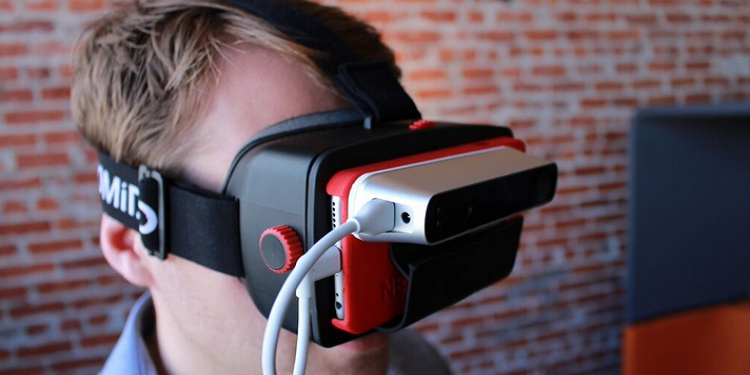- Structure Sensor
- 3D printed NEODiMOUNT case and matching NEODiVR conversion plate
- HOMiDO VR headset
- iPhone 6
While you can try this out if you are on hand today at the Expo, it’s easy to put together if you own the iPhone and a Structure Sensor. If so, all you will need extraneously is the HOMiDO VR headset and the ability to 3D print a custom attachment piece to create the system.
This is a spectacular AR gizmo that allows you to enter another world right from your living room or yard. Previously this technology was connected only to the iPad; with the inception of the iPhone 6, however, the entire setup is able to be transferred to the smartphone.
“You may remember that I’ve covered the previous version at CES of this device when we had it hooked up to a tablet,” says Michael Balzer of All Things 3D. “At that time I thought what a great idea if we could apply this to a headset, so I spent the last six months creating what I call NEODiVR.”
One puts on the headset and connects the Structure Sensor, which quite simply adds a depth sensor allowing every step you take in your living room to be recreated in the virtual world, whether you are crouching like a ninja or high-stepping it in pure unabashed fun.
“What they have done by attaching the sensor to the actual screen means they now are able to project the prime sensor feel or pattern and pick up the mesh information in real time of the objects around them,” says Balzer.”
This means you aren’t just going into the technology blindly either as physical objects are introduced into the VR world, eliminating the risk of tripping, embarrassment, and bodily injury.
It is a compact mobile device requiring no power source, and allows you to use 3D printing brackets to attach it to the iPhone or to an iPad with a Lightning connector. It allows your smartphone to understand the world in 3D.
The sensor is a hardware platform that works quite well on an iOS device, allowing you to:
- Perform 3D mapping of indoor spaces, with measurements and ‘virtual redecoration’
- Integrate AR games where virtual is completely connected to the physical world
- Use body scanning during fitness tracking, as well as virtual clothes fitting
- Play virtual reality games using 3D environments imported from the real world
- Perform 3D object scanning just using the app, without hardware
Does this look like a VR/AR device you’d like to put together yourself and try out? Will you or were you on hand at AWE 2015 to check this out? Tell us about it in the Occipital’s NEODiVR AR/VR System forum over at 3DPB.com.
